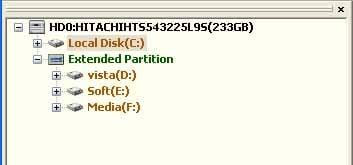A hard disk must be partitioned before it is used. Partitioning is the process of dividing the space of hard disk into chunks so that they can be prepared for use. There are three types of partitions, i.e. primary partition, extended partition and logical partition.
Primary partition
Primary partition is a partition which is used to save and boot an operating system. Usually the operating system is installed in a primary partition which can be set “active” so that the computer can locate the operating system that needs starting.
If you have more than one primary partition on your hard disk, only one of them can be visible and active at a time. This active partition is the partition from which the operating system is booted at computer startup. There are at most four primary partitions (or three primary partitions and an extended partition) on a hard disk
Extended partition
Extended partition is a kind of special primary partition which can be subdivided into logical partitions. It can be seen as a container for logical partitions. A hard disk can contain only one extended partition and it is not formatted or assigned a drive letter, for it is used to create logical partitions.
Logical partition
Logical partitions are partitions created in extended partition. Logical partitions are similar to primary partitions. However, the number of logical partitions that can exist on a hard disk is unlimited.
An extended partition does not directly hold data and logical partitions are mainly used for storing data. Once created, logical partitions must be formatted and each may be assigned a drive letter.
You can view partition types easily through partition manager PartitionGuru and operation steps are as follows:
Start PartitionGuru and on the “Partition and Folder Tree”, the left part of the main interface, you can see the partition types, as below:

The picture above shows the partitions of a real computer; the computer has one hard disk (HD0) and the hard disk has a primary partition (Local Disk) whose drive letter is C; there is one extended partition and this extended partition has three logical partitions (vista, Soft and Media) whose drive letters are D, E and F.
